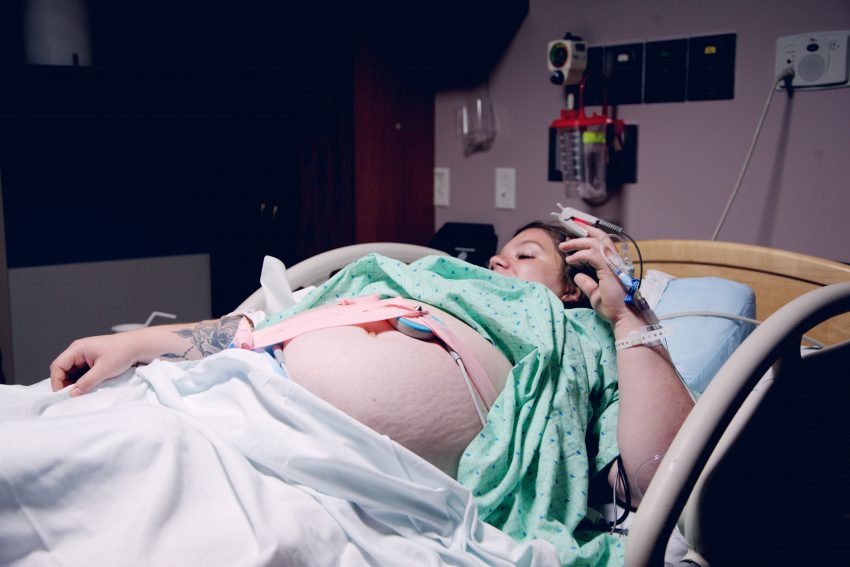They call it Synthetic Oxytocin. “Syntocin or Pitocin” nowadays is by far the most common medical intervention in childbirth.
What is synthetic oxytocin?
Endogenous oxytocin is a key component in the transition to motherhood. It affects molecular pathways that buffer stress reactivity, support positive mood, and regulate healthy mothering behaviors (including lactation). It reduces endogenous oxytocin levels (bond hormone and love). With low to non-existent endogenous oxytocin levels in the mother, direct attachment to her baby decreases as the use of synthetic oxytocin increases the likelihood of melancholia (maternity- baby blues) during postpartum. By giving women synthetic oxytocin during delivery, we interfere with hormone balance. And there is growing evidence that there are long-term consequences.
Furthermore, synthetic oxytocin may be given electively at the onset of the third stage of labor and is commonly used as a uterotonic agent during a cesarean section. Also, as far as breastfeeding is concerned, the letdown reflexes are reduced. So, the newborn does not get enough milk even if it is properly breastfeeding. Women who breastfeed their children up to two months after birth had received significantly less synthetic oxytocin than women who did not breastfeed exclusively their children. There are theoretical reasons to test the hypothesis that, the increasing incidence of breastfeeding difficulties and the frequent earlier than desired cessation of breastfeeding are related to the use of synthetic oxytocin during labor. Specifically, intravenous glucose infusion for many hours and synthetic oxytocin cause breast swelling. Mothers as a result feel pain and are unable to conceive the nipple from the newborn.
How synthetic oxytocin affect us mentally?
But oxytocin does not only affect our body (causing uterine contractions in childbirth). It also extends to our emotions in many ways. Oxytocin – the hormone of love – does another job. It prepares you for emotional bonding with your baby ( it acts as a neurotransmitter to the brain). Artificial oxytocin blocks the receptors of natural oxytocin, which makes it difficult for the body to produce the hormone of love (the artificial has no such property). So you find it difficult to establish this deep emotional bond with your child after the beginning of breastfeeding. M. Odent states that “Oxytocin is the key to our emotional world”. Unfortunately, the prevailing view is that synthetic oxytocin serum is no different from the natural oxytocin. Higher doses of synthetic oxytocin are associated with a higher incidence of maternal depression and anxiety.
The childbirth must begin spontaneously. The natural development of childbirth allows the mother to produce oxytocin alone – as much as she can afford. 80% of women feel that it greatly increases the pain of childbirth. The use of epidural anesthesia is increased twelve times when the serum is preceded. More specifically, immediately after the use of synthetic oxytocin, a “cascade of interventions” begins a series of additional interventions. Some of these are the premature rupture of the amniotic sac (the “breaking of the water”), the cardiograph, immobility, the bladder catheter, the epidural. Also, an episiotomy is possible to be done and very often the use of vacuum, and necessarily much greater perineum. Other times the delivery results in a cesarean section.
What problems can cause?
Except for the intervention that the use of synthetic oxytocin can start, other health issues may possibly arise. As ACOG (American College of Gynecology) research has shown that synthetic oxytocin was responsible for 43% of complaints to physicians for newborn neurological damage. Furthermore, because it causes fetal difficulty often, as Pitocin can cause the baby to have difficulty getting oxygen, it greatly increases the rates of cesarean section. Another study in Australia in 2004 showed that autistic children are more than twice as likely to be born with induced childbirth or cesarean section.
Synthetic oxytocin is not indicated for induction of labor (instructions are spelled out clearly) although it is often used for this purpose in combination with other medicines and techniques. According to W. H. O, there are specific reasons when to induce labor with synthetic oxytocin.
The only reason for using synthetic oxytocin is to stimulate the uterus in case of fatigue or inactivity. That is when natural oxytocin is not sufficient.
Just like natural oxytocin can’t make you a good mother if you don’t want to. The use of synthetic oxytocin doesn’t define us as “bad mothers” but it is a wrong practice to use it recklessly. It makes motherhood work difficult and can put a mother and infant at risk during childbirth. As Ina May Gaskin says “ What gets the baby in, gets the baby out”.
Sources:
M.Odent, Synthetic Oxytocin, and breastfeeding. Reasons for testing a hypothesis, Medical Hypothesis 81, 2013, p 889- 891
Feeley N et al., Intrapartum Synthetic Oxytocin and its effects on Maternal well being at 2 months postpartum, Birth, 2016
Malek A et al, Human placental transport of oxytocin, Maternal-Fetal Med, 1996, p 245-255
Effects of Intrapartum Oxytocin Administration and Epidural Analgesia on the Concentration of Plasma Oxytocin and Prolactin in response to suckling during 2 day postpartum, Breastfeeding Medicine, 2009, p 70- 82



